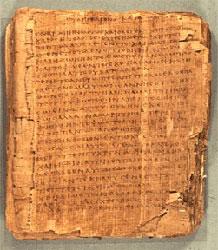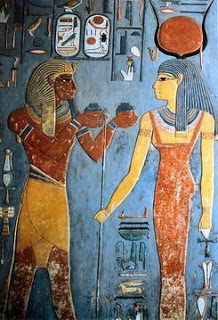As it turns out, both my Deities are Wine Deities. Although my sweet mad Dionysos is more known for His wine-y associations, Isis too, is connected with wine. We had our annual Grape Stomp last night and crushed the syrah we have growing in our backyard. (Yes, thank you, it was fabulous.) I must tend to the must (the crushed grapes ready to ferment) presently. But for now, a little bit about Isis as Lady of Wine…
The grapevine is not native to Egypt, but by the early third dynasty, Egypt had a viticulture industry all its own. Still, wine was expensive and it was generally reserved for the wealthy and priestly classes, for tomb offerings, and for the Goddesses and Gods. The Egyptians made both red and white wines; a Greek writer commented quite favorably on the quality of Egyptian white wine. Due to its Mediterranean climate and the greater availability of water, most ancient Egyptian vineyards were located in the Nile delta…though I just learned that Isis’ temple at Philae owned a vineyard, too.
Several delta cities had a reputation for their fine wines, including Sebennytos, the town near Isis’ great temple at Isiopolis. It was common for temples to have their own vineyards (see Philae above). There was even a tradition in Egypt that, on occasion, the water of the Nile turned to wine. Epiphanius, the early Christian polemic writer, tells us that many people attested to this Nile-water-into-wine miracle. Of course to Epiphanius it was a Christian miracle, taking place on the 6th of January and commemorating Jesus’ water-into-wine miracle.
The Goddesses Hathor and Bastet are both associated with wine and beer, especially during Their Festivals of Intoxication where imbibing was part of the worship. The Winepress God, Seshmu, is also known from the funerary texts. He brings grape juice to the king for wine production, gives wine to the deceased—and crushes the heads of enemies and wrongdoers in His bloodthirsty winepress.
Yet if there is one Egyptian Deity Who has the most right to the title of God of Wine, it is Osiris, the husband of Isis. Osiris is known as Lord of Wine as early as the Pyramid Texts and His identity as such only grew as time passed. In a magical papyrus from the second century CE, the “blood of Osiris,” clearly wine, is poured into a wine cup, and is to be given to a woman as part of an erotic spell: “Give it, the blood of Osiris, that he gave to Isis to make her feel love in her heart for him night and day at any time, there not being time of deficiency.”
No doubt, the association of Osiris with wine is the reason that one story tells us that Isis became pregnant with Horus by eating grapes. Isis Herself is also given the epithet Mistress of Wine and Beer.
In addition to Her marriage to the Lord of Wine, Isis has Her own associations with the vine and with the Greek Wine God Dionysos. The Greeks considered the sacred star of Isis, Sirius, to be the bringer of wine since its late-summer rising coincided with the beginning of the harvest season. Ancient writers also speculated on a variety of Isis-Dionysos connections. One said that Dionysos is the son of Zeus and Isis. Another called Isis the daughter of Prometheus and said that She lived with Dionysos.
Wine can also be associated with Isis as a Healing Goddess. Wine and beer were the delivery media for many an ancient remedy. Ancient medicines often listed a variety of herbal ingredients to be put into wine, then the patient was to drink the potion for a particular number of days. And, of course, as Goddess of Magic, Isis is often part of the cure for “Magic is effective together with medicine. Medicine is effective together with magic,” according to the Ebers medical papyrus. The papyrus even begins with a prayer to Isis, Great of Magic.
As for other Deities, wine was a common offering to Isis. Due to its costliness, it was a valuable offering, but wine was also thought to temper the sometimes-fierce nature of the Goddess. For, like Hathor and Sakhmet, Isis could be offered wine to “make Her heart rejoice” so that She would not be angry. Temples of Isis in Egypt and even further afield bear evidence of offerings of wine. Isis’ temple at Philae has wine-offering scenes carved on every doorway lintel down the central axis of the temple, as well as in side sanctuaries and on exterior walls.
A wine cup dated to 73 CE was found in a shrine of Isis on the island of Paos in the Aegean and includes an inscription to “Isis the Great.” An ancient Roman wine jug discovered in Southwark, England has an inscription that reads: Londini ad Fanum Isidis (“to the Temple of Isis in London”).
Wine vessels are included in the Roman Isis procession described by Apuleius, yet candidates for initiation into the Mysteries of Isis had to refrain from drinking wine for ten days before an initiation.
Isis, the Mistress of Wine, is married to Osiris, Lord of Wine, and Their Holy Child is conceived by the consumption of grapes. And so our Lady is both the green Goddess of the vine and the purple Goddess of the wine.






Reblogged this on Sanctuary of Horus Behdety.
Arrived at a Dionysus-Isis connection myself. In fact the prominence of phallic imagery in Dionysus worship could have originated in the loss of Osiris’ upon his resurrection, as well as Dionysus sometimes effeminate portrayals. And, as the name of Dionysus is of unknown origin perhaps it was from dion-isis, “heavenly Isis”. In my tradition Isis resurrected Osiris by merging herself with his bones, becoming Isis-Osiris, man-woman combined. The Greeks even identified Dionysus with Osiris… but it was Isis too. Another potential association is to Odin who hung on the tree.